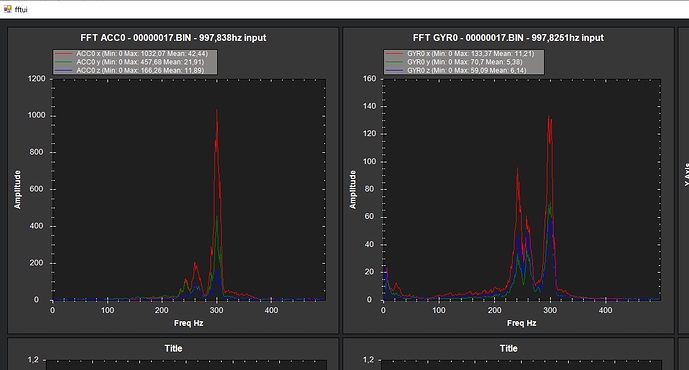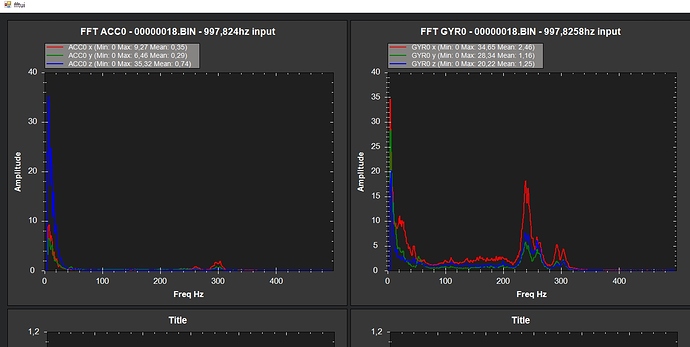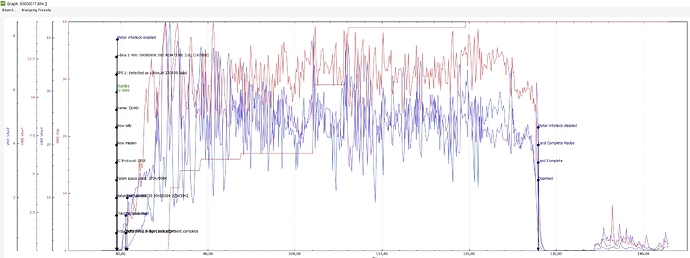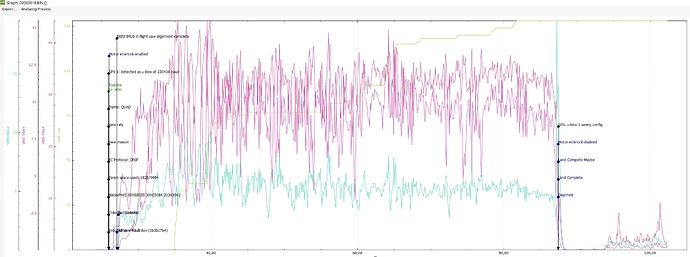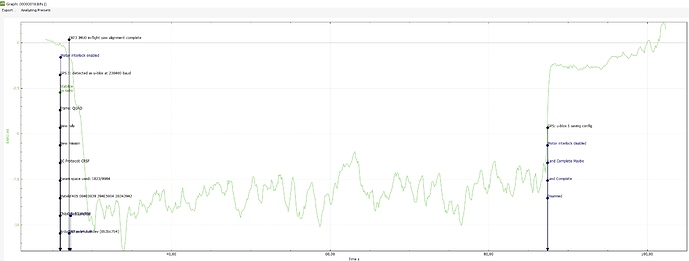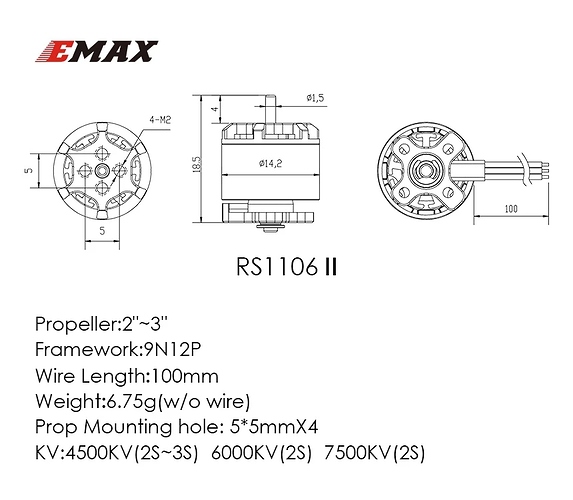Throttle percentage would represent the stick position as it’s RC input from the Receiver. But single motor output (what you plotted) on a multirotor is a highly processed signal that depends on many factors.
Ok, that explains that, it was in STABILIZE. Just out of curiosity, does that mean I’d theoretically have a better chance of stopping a falling copter by switching to manual? (Of course keeping it stable manually under such conditions would be another issue.)
That leaves the odd throttle display in the OSD, I posted a log of the big copter here in my crash investigation thread.
Almost forgot that I maidened the little ArduCopter today, albeit in some thick fog, so it was only a 2 minute flight. I hope the fog also accounts for the fact that I didn’t get a GPS fix… but the compass was working great. 
In the meantime I was able to do some real flights. Everything was generally working, including ALTHOLD and LOITER. But the predictions back in September were correct: vibrations are sky-high on the tiny frame.
So I tried the dynamic harmonic notch filtering, based on ESC telemetry (indoor hover in STABILIZE).
On paper, the effect was really obvious:
Yet for some reason, the vibrations didn’t seem to be affected much:
There are still things left I plan to do to reduce vibrations, like putting the FC on a soft-mount plate, but I’m just wondering if the effect shouldn’t be more obvious and if I overlooked something.
Second (any maybe related) thing: On every flight, the altitude sinks into negative values.
I wonder if this is also caused by the vibrations? The baro seems to be working perfectly normal as long as motors are not running. Before building my first ArduCopters, I read a lot of stories here about copters shooting up into the sky due to vibrations, because AC was assuming the craft is descending. Fortunately this doesn’t seem to happen here. In fact, ALTHOLD works, even at an assumed altitude of -5 meters…
How are you driving the notch? You should be able to do a lot better than this. I recommend you use 4.1 and ESC telemetry if you can or in-flight FFT if not.
Vibes are unffected by the notch except as a second order effect (notch only filters gyros).
Yes, I’m using 4.1 and INS_HNTCH_MODE = 3 with ESC telemetry. I set INS_HNTCH_FREQ to 300. INS_HNTCH_BW however could not be set to half of that, as indicated here, as 150 would be out of range. I was hesitant to set it to absolute max (which was actually 80 in MP, not 100 as indicated here, so I set it to 40 for now. Maybe it should be more?
1000 to 2 on the left and 130 to 5 on the right at 300Hz looks like a big reduction to me, but I’m not really good with numbers, so I’m sure I mixed something up. 
This was just a first indoor test to see if things go into the right direction.
Generally, can the negative altitude be related to this or is it a separate issue?
Yes your BW is the problem. For ESC telemetry (and FFT) it is the ratio of freq to BW that is most important. This defines the Q and is kept constant. So it would be fine to set these to 80/40 say and still get the right values at higher frequencies
The docs for BW are wrong - I’ll get them changed. You can set the out of range value quite happily.
Do you have something like this on your fc?
Yes, but it’s not enough. I will be putting this on, works great on my bigger copter:
Hint: Avoid XT-Xinte, worst China shopping experience I ever had.
I’m not sure I understand completely, you mean 80 for frequency and 40 for bandwidth?
Yes, exactly. The code will scale this to the appropriate frequency keeping the shape the same. This is how it works for multiple harmonics if you set 80/40 and want to cover two harmonics then the next harmonic will be 160/80, not 160/40.
Also make sure you are using INS_HNTCH_OPTS=2 to cover motors individually
Ok I see, multiple harmonics, I know that from audio - that’s indeed totally different from what the docs said, and INS_HNTCH_OPTS wasn’t even mentioned.
It looks like the notch filter tuning process is not needed much, otherwise someone else might have already noticed the outdated docs. Probably on bigger quads it’s not needed, at least it wasn’t on mine.
With ESC telemetry there is not much tuning to be done - its only with throttle driven notch that you need to tune.
So I will be trying the following now:
INS_HNTCH_ENABLE=1
INS_HNTCH_MODE = 3
INS_HNTCH_OPTS=2
INS_HNTCH_FREQ=80
INS_HNTCH_BW=40
Does that mean I could simply use these same settings on my bigger quad as well, without looking at the FFT graphs at all?
Pretty much. The only thing that might mean you want to check the FFT is if you are not sure whether you have got the number of motor poles right or not. For smaller motors this is often 12 rather than 14 - and getting it right makes a big difference.
-
Should I also set INS_HNTCH_HMNCS ?
-
One thing keeps leading to another… Never cared about motor poles so far.
 So these motors are 4500KV, and I’m getting RPM readings at hover with 3S of about 14000 to 16000 - does that sound right? And can the number of poles be guessed from this schematic?
So these motors are 4500KV, and I’m getting RPM readings at hover with 3S of about 14000 to 16000 - does that sound right? And can the number of poles be guessed from this schematic?
-
If you have INS_HNTCH_OPTS=2 then harmonics is ignored. This puts a notch on each motor rather than a series of harmonics from a single frequency. Note that it only works for quads - not recommended for 6 or 8 motors.
-
12 poles - that’s what the 12P in 9N12P is
That’s good info to know, didn’t realize it or passed it over if you mentioned it before.
It’s probably not as bad as that. What should happen is you get notches on the first four motors, but on bigger quads that may not be what you want - generally small quads with their stiff light frames get a single massive peak, on the bigger quads with all of their noisy, bouncy things going on a single notch centered on the motor average with harmonics may kill more of the noise.
Ok, I’m reviving this thread as history is repeating itself (partly at least). I eventually got the original 3" project flying ok - but there was always just too much interference, GPS glitches etc., due to the small size and the components being too close together. It was also easy prey for the wind and had very short flight times.
So I swapped the 130mm frame for a 180mm one and the 1106 motors with 3"/2.5" (tried both) props for 1805 motors with 4" props. I then ran the initial settings calculator for a 3S 4inch quad which resulted in the following changes:

And once again, it won’t really take off. No visible oscillations at all this time (FC is mounted ultra-soft now) but simply not enough thrust. Here’s the log:
I checked radio calibration, PWM output, ESC PWM range… everything seems ok to me. But still there must be some silly mistake somewhere.
The battery is a 3S 1800 mAh with a rather low C rate but that shouldn’t keep the quad from at least climbing I guess. I also tried another battery and the result was even worse.
Thanks for any hints!
What is the take-off weight? RCouts commanded to max, battery sags a ~1V and stuck on the ground. Also, do you have the barometer covered with some foam? On your take-off attempts the baro shows a drop of ~4m. That will be trouble.
I don’t see any evidence of that…
